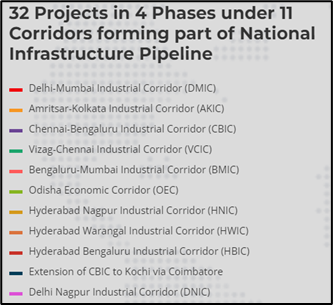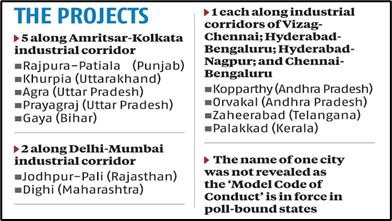Why in News?
The Cabinet Committee on Economic Affairs (CCEA), chaired by the Prime Minister, approved 12 “industrial smart cities” in 10 states to boost domestic manufacturing with an estimated investment of Rs 28,602 crore.
This follows the Finance Minister’s announcement during the Union Budget 2024-25 speech, in which she outlined a plan to sanction 12 industrial parks under the National Industrial Corridor Development Programme (NICDP).
What’s in Today’s Article?
- What is the National Industrial Corridor Development Programme (NICDP)?
- Key Highlights of the Industrial Smart Cities
- Significance of the Industrial Smart Cities
What is the National Industrial Corridor Development Programme (NICDP)?
- It is India's most ambitious infrastructure programme aiming to develop new industrial cities as "Smart Cities" and converging next generation technologies across infrastructure sectors.
- It is aimed at development of futuristic industrial cities in India which can compete with the best manufacturing and investment destinations in the world.
- The same will create employment opportunities and economic growth leading to overall socio-economic development.
- 11 Industrial Corridors Projects are being taken up for development with 32 Projects to be developed in 04 phases up to 2024-25:

Key Highlights of the Industrial Smart Cities:
- The chosen cities for the industrial projects:
- Strategic investments:
- NICDP is designed to foster a vibrant industrial ecosystem by facilitating investments from both large anchor industries and Micro, Small, and Medium Enterprises (MSMEs).
- These industrial nodes will act as catalysts for achieving $2 trillion in exports by 2030, reflecting the government's vision of a self-reliant and globally competitive India.
- Smart cities and modern infrastructure:
- The new industrial cities will be developed as greenfield smart cities of global standards, built "ahead of demand" on the 'plug-n-play' and 'walk-to-work' concepts.
- This approach ensures that the cities are equipped with advanced infrastructure that supports sustainable and efficient industrial operations.
- Aligned with the PM GatiShakti:
- Aligned with the PM GatiShakti National Master Plan, the projects will feature multi-modal connectivity infrastructure, ensuring seamless movement of people, goods, and services.
- The industrial cities are envisioned to be growth centers for transformation of the whole region.
Significance of the Industrial Smart Cities:
- Vision for a 'Viksit Bharat': The approval of 12 new industrial nodes under the NICDP is a step forward in realising the vision of ‘Viksit Bharat’ - a developed India.
- Positioning India as a strong player in the Global Value Chains (GVC):
- These projects will provide developed land parcels ready for immediate allotment, making it easier for domestic and international investors to set up manufacturing units in India.
- This will mark a significant milestone in India's journey towards becoming a global manufacturing powerhouse and aligning with the broader objective of creating an 'Atmanirbhar Bharat' or a self-reliant India.
- Economic impact and employment generation:
- NICDP is expected to generate significant employment opportunities, with an estimated 1 million direct jobs and upto 3 million indirect jobs being created through planned industrialization.
- This will not only provide livelihood opportunities but also contribute to the socio-economic upliftment of the regions where these projects are being implemented.
- Commitment to Sustainable Development:
- The projects under the NICDP are designed with a focus on sustainability, incorporating ICT-enabled utilities and green technologies to minimise environmental impact.
- By providing quality, reliable, and sustainable infrastructure, the government aims to create industrial cities that are not just hubs of economic activity but also models of environmental stewardship.










